Ubuntu 16.10: Convergence is in a holding pattern; consistency’s here instead
This article was published in Ars Technica, you can view the original there, complete with graphics, comments and other fun stuff.
There’s plenty in Ubuntu 16.10 that makes it worth the upgrade, though nothing about Canonical’s latest release is groundbreaking. This less experimental but worthwhile update continues to refine and bug-fix what at this point has become the fastest, stablest, least-likely-to-completely-change-between-point releases of the three major “modern” Linux desktops.
Still, while the Unity 7.5 desktop offers stability and speed today, it’s not long for this world. Ubuntu 16.10 is the seventh release since the fabled Unity 8 and its accompanying Mir display server were announced. Yet in Ubuntu 16.10, there’s still no Unity 8 nor Mir.
In Canonical’s defense, the competing display server project, Wayland, hasn’t exactly taken the world by storm. Wayland will likely be the default for the Fedora Project’s next release, Fedora 25. But the difference is that GNOME 3 isn’t tied to Wayland and has been cranking out impressive releases for some time now while Unity 7.5 is feeling, well, a bit dated.
It’s worth noting that Ubuntu 16.10 is the first official release of Ubuntu to ship with Unity 8 and Mir available. And users can even try out a Unity 8 session by clicking the Ubuntu symbol next to their username when they log in.
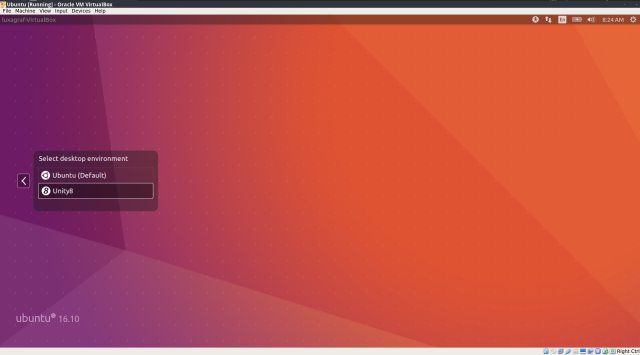
Good luck getting Unity 8 to run, though. Older hardware isn’t up to the task, and most new Nvidia-based hardware won’t work either. For this review, I used both a Dell XPS and System 76 Oryx Pro—neither one of these very modern, well-specced pieces of hardware can successfully boot to Unity 8. Most disappointing, the accounts I’ve seen of people who can get Unity 8 running (like this video) show a streamlined Unity interface with… a new set of icons and some UI elements reminiscent of GNOME Shell. It’s banal enough—at least within the skin-deep look we can get right now—to make you wonder what the fuss is about.
Of course, the fuss is about “convergence.” The fuss is about the purported future in which you plug your phone into a monitor and it turns into a full desktop computing experience. I’ve started to feel like Fox Mulder waiting for Unity 8. I want to believe. I really do, but I’ve started to think convergence is about as likely as the zombie apocalypse. The truth, the reality we’ll end up with, looks to be somewhere below Canonical’s fantasies of do anything phones and flesh-eating updates that install Windows instead of Linux.
All of that is to say: Unity 8 still isn’t here yet. Users should probably stop holding their breath waiting for it to arrive.
In the meantime, Canonical has shipped a very nice desktop operating system that’s fast and stable. Ubuntu 16.10 has fixed most of the issues that plagued the 16.04 release, which was supposed to be the Long Term Support release. If it were up to me, I’d much rather support Ubuntu 16.10 for five years than 16.04, so luckily most of what’s great about 16.10 will be backported to 16.04 at some point. If you were bitten by 16.04, but not bitten hard enough to want to get off the LTS bandwagon, sit tight. Backports are on the way.
Kernel 4.8
The biggest and best news to arrive with 16.10 is probably the move to Linux kernel 4.8. Earlier this year I called kernel 4.6 one of the best to come along in years (paraphrasing Linux Torvalds)… but 4.8 is a significant upgrade for the additional hardware support. In particular, there are three notable developments in 4.8: improved Skylake support, better support for Nvidia Pascal, and support for the raspberry pi 3.
Skylake has been a very hit or miss series of chips in both Linux and Windows, though it seems particularly prone to problems in Linux. Kernel 4.8 fixes a Skylake power management bug that can crash your system and seems to generally be much more stable than earlier releases. I still occasionally experienced a bug with Chromium and YouTube both on Ubuntu and Arch running 4.8, but otherwise 4.8 has solved all the problems I previously noticed on Skylake machines.
Nvidia Pascal cards get some love in this update as well. The new support applies to the open source Nouveau driver, and while it’s far from complete, it’s a start. I’d still suggest sticking with Nvidia’s proprietary drivers for now, but at least Nouveau support is in the works.
The Raspberry Pi 3 support is good news for anyone looking to get Ubuntu installed. Previously, Linux kernels had to be patched to work with the Raspberry Pi 3, which in practical terms meant you needed the Debian-patched Raspbian. Now, RP3 support is native to the Linux kernel, meaning any distro should run just fine provided you turn off any graphics-intensive UI.
There are also a couple of more universal improvements to ACPI low power mode, which might squeeze a few more minutes out of your laptop battery. Equally big improvements to USB camera and HDMI device capture will be welcome to those of you editing video in Linux.
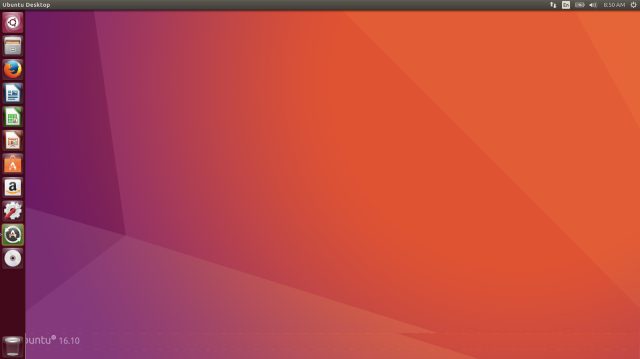
Unity 7.5
The most noticeable difference in 16.10’s Unity desktop is the speed improvement. Unity is just plain fast. Applications launch quickly, windows minimize quickly, suspend resumes quickly, and even boot time is minimal.
This release also sees some significant updates to the GNOME components and applications that Unity depends on, bringing most of the GNOME stack up to version 3.20 (a couple appear to be at GNOME 3.22, which is downright cutting edge by Ubuntu’s backporting standards). Nowhere is this more noticeable than in the Nautilus file browser, which gains the new search filters, progress indicator, and icon size control that GNOME users have enjoyed for some time now.
In Ubuntu, the best of these new features is the greatly improved search features. These are not only much faster, but they also allow you to chain filters together. Files, as Nautilus is known these days, comes with a much more compact preferences dialog, too. It offers new settings for showing the permanent delete and create symbolic link buttons.
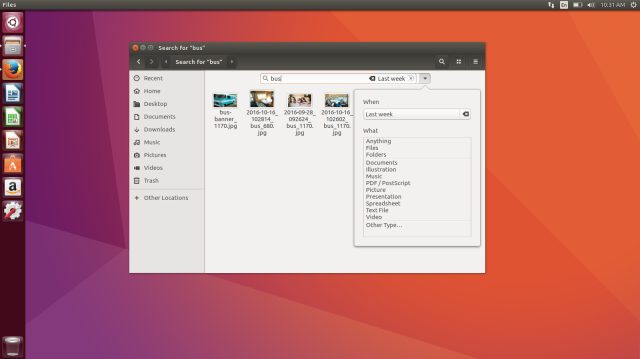
Much of the rest of the standard GNOME-based Unity application stack has been updated to the latest version. LibreOffice has been updated to 5.2, Firefox is at 49. Another under-the-hood change that some users may be pleasantly surprised by is the move to GTK3 apps (when available). LibreOffice is one example of this, and it looks much better than previous releases. On the other hand, this could end up breaking some themes, so if you’re very attached to some customized Unity theme I highly recommend testing it with 16.10 in a virtual machine before you commit to upgrading.
Speaking of virtual machines, Ubuntu 16.10 is noticeably faster in VMs than previous releases. This is primarily due to the new Unity Low Graphics Mode, which tones down the fade effects and transparency in favor of faster rendering times.
Unfortunately, one place Unity seems to lag behind GNOME is in detecting HiDPI screens. While 16.10 has excellent HiDPI support, it never detected my screens; instead I had to manually turn on scaling. It’s a minor point to be sure, but a new user who doesn’t know that they need to turn on dpi scaling might be quite lost while staring at tiny text on a 4k monitor. It’s worth noting that Unity did successfully detect that my Virtualbox install was using a HiDPI screen (on the same hardware where, when installed to disk, it did not).
Also worth noting, systemd is now used for user sessions. Previous releases (this one included) used systemd for system sessions, but not user sessions. Upstart, Ubuntu’s previous session manager, is still around for Unity and some indicators, but these are in the process of being migrated to systemd. Soon it will be just systemd turtles all the way down.
While there hasn’t been much done to the Ubuntu Software Center in this release, there are some better search tools available for the nascent Snap packages system. The easiest way to find Snap packages is still with the command line tool (e.g. “snap find appname”), but a fair number of Snap packages do turn up in the Ubuntu Software Center. Despite the promise of Snap packages—installing apps without worry about dependencies being probably the biggest win for end users—developers do not appear to be rushing into Snaps. There are Snap versions of popular apps like LibreOffice and the graphics tool Krita in addition to other, smaller projects, but there remain plenty of issues with Snap apps and far too few Snaps to get very excited at this point.
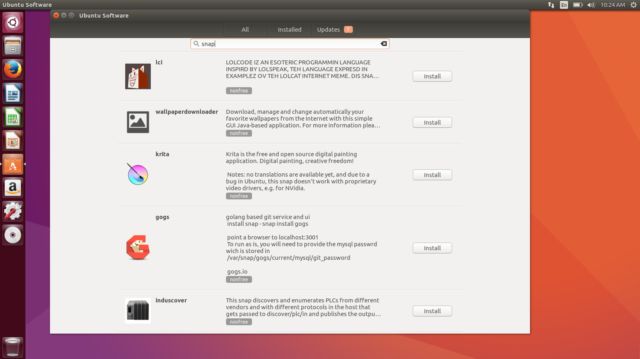
It may well be that app developers are waiting a bit to see which of the container-meets-package formats will end up rising to the top. Ubuntu’s Snaps are more or less the same (conceptually anyway) as Flatpak packages, which grew out of a Red Hat-led effort.
Stability and Performance
Despite feeling a bit faster, Ubuntu 16.10 was a bit more resource heavy than its LTS predecessor. I found that idle performance for 16.10 was nearly identical to 16.04, though 16.10 was using about 25 percent more RAM. There’s better news when it comes to power use, though. Using the powerstat application (developed by an Ubuntu engineer, Colin King) with brightness at full, Wi-Fi on, and Bluetooth off, I found 16.10 used roughly 10 percent less energy. At least some of that progress may be due to the aforementioned kernel power management improvements, though. In other words, once it’s backported to 16.04, power consumption may be much closer. In the meantime, 10 percent marks a significant improvement.
Another place I found Ubuntu 16.10 a giant leap ahead of 16.04 was stability and bugs, and generally this is the opposite of what I would expect. Ubuntu’s October releases tend to be more experimental, a place for developers to try reasonably stable new ideas that might still have a bug or two. Unfortunately, I found 16.04 to be quite buggy—which could have been related the Skylake issues upstream from Ubuntu itself—as released, though things have settled down a bit now.
With 16.10, all my trackpad issues and X session crashes have vanished (save the aforementioned Chromium/YouTube bug). Once again the majority of the stability fixes will likely be backported to 16.04, but if any of these or other bugs have bitten you with 16.04, it might be worth making the leap to 16.10 to see if that improves your experience.
Flavors
Unity is the flagship Ubuntu release, but by no means the only way to enjoy Ubuntu. The list of improvements in 16.10 for Ubuntu’s various flavors is beyond the scope of a short review like this, but there are two releases in particular that deserve mention. The first is not technically a flavor, but it’s already the most used version of Ubuntu out there—the server edition.
Ubuntu 16.10 includes the latest OpenStack release, dubbed Newton, as well as updated versions of OpenStack’s various components. Again, this will also be available to Ubuntu 16.04 LTS users, so there’s no need to move your production server off the purportedly more stable LTS release just to get the latest version of OpenStack. You might want to give some thought to whether you want to upgrade at all given what a headache it can be. Even the Ubuntu release notes offer a warning that “upgrading an OpenStack deployment is a non-trivial process and care should be taken to plan and test upgrade procedures which will be specific to each OpenStack deployment.” (But really, the cloud makes everything so simple right?)
All of Ubuntu’s various flavors have updates for 16.10. Ubuntu GNOME has migrated some applications to GNOME 3.22, though the core system components like gnome-shell, gnome-control-center, and nautilus are still at 3.20. Kubuntu 16.10 has a new version of Plasma 5 and updates for the stock KDE applications.
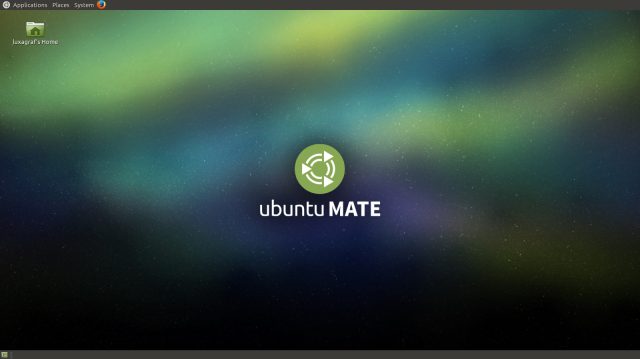
Ubuntu MATE has turned out another great update and is notable for being the first distro to ship MATE 1.16. The big news in MATE 1.16 is full GTK3+ support. The move to GTK3+ is a big one, and it smooths out many of the graphical rough edges of past releases. The HiDPI support—one of the big benefits of the move to GTK3+—is still a work in progress, however. I was able to get it working pretty well in a virtual machine, but on the hardware site it didn’t work.
Developer Martin Wimpress says that HiDPI support will be an area of focus for Ubuntu MATE 17.04. But even without full HiDPI support, Ubuntu MATE feels like what Ubuntu would have become if the Unity interface had never come along. In that sense, it’s nice to know that if you don’t like Unity for some reason, you can still use Ubuntu just like you used to; they’ve merely added the word MATE to the name.
Conclusion
For all its improvements, Ubuntu 16.10 is not a huge update. It has all the benefits of kernel 4.8, so if you had issues with 16.04 I would definitely suggest upgrading. However, most of the bug fixes and other speed and stability improvements will be backported to 16.04 eventually—you’ll simply have to wait a bit longer.
If you want to experiment with Unity 8, then 16.10 is again well worth the upgrade. Before taking that leap, make sure you have a graphics card and drivers that Mir supports. Also be forewarned that even if you get Unity 8 running, most applications won’t install. It really is very much experimental still.
While it has been a welcome improvement over 16.04 for me (mostly due to hardware issues with 16.04), Ubuntu 16.10 still feels very much like Ubuntu is in a holding pattern. Canonical seems to be waiting for Unity 8 to mature or at least become stable enough to use for more than a two-minute screen capture video.
Ubuntu’s planned future continues to look bright. Combining Snap packages, Mir, and Unity 8 would make for an impressive system, so if it can realize its vision of convergence, Canonical may really be on to something. Unfortunately, for now that future feels no closer than it did this time last year.